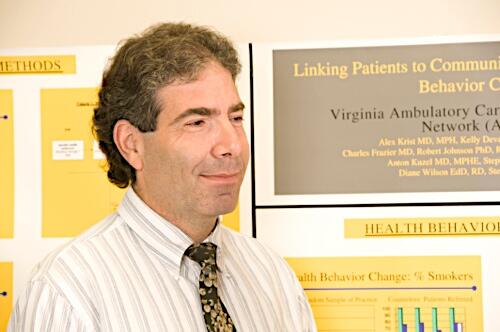
Jan. 9, 2013
Americans have Worse Health than People in Other High-Income Countries
Share this story
On average, Americans die sooner and experience higher rates of disease and injury than people in other high-income countries, says a new report from the National Research Council and Institute of Medicine. The report finds that this health disadvantage exists at all ages from birth to age 75 and that even advantaged Americans – those who have health insurance, college educations, higher incomes and healthy behaviors – appear to be sicker than their peers in other rich nations.
“We were struck by the gravity of these findings,” said Steven H. Woolf, M.D., professor of family medicine in the Virginia Commonwealth University School of Medicine and chair of the panel that wrote the report. “Americans are dying and suffering at rates that we know are unnecessary because people in other high-income countries are living longer lives and enjoying better health. What concerns our panel is why, for decades, we have been slipping behind.”
The report is the first comprehensive look at multiple diseases, injuries and behaviors across the entire life span, comparing the United States with 16 peer nations – affluent democracies that include Australia, Canada, Japan, and many western European countries. Among these countries, the U.S. is at or near the bottom in nine key areas of health: infant mortality and low birth weight; injuries and homicides; teenage pregnancies and sexually transmitted infections; prevalence of HIV and AIDS; drug-related deaths; obesity and diabetes; heart disease; chronic lung disease; and disability. Visit Mortality Rates: How the U.S. Compares for more information.
Many of these health conditions disproportionately affect children and adolescents, the report says. For decades, the U.S. has had the highest infant mortality rate of any high-income country, and it also ranks poorly on premature birth and the proportion of children who live to age 5. U.S. adolescents have higher rates of death from traffic accidents and homicide, the highest rates of teenage pregnancy and are more likely to acquire sexually transmitted infections. Nearly two-thirds of the difference in life expectancy between males in the U.S. and these other countries can be attributed to deaths before age 50.
These findings build on a 2011 Research Council report that documented a growing mortality gap among Americans over age 50.
“It’s a tragedy. Our report found that an equally large, if not larger, disadvantage exists among younger Americans,” said Woolf, who is also director of the VCU Center on Human Needs and the co-director of the Community Engagement Core within the VCU Center for Clinical and Translational Research. “I don't think most parents know that, on average, infants, children and adolescents in the U.S. die younger and have greater rates of illness and injury than youth in other countries.”
The panel did find that the U.S. outperforms its peers in some areas of health and health-related behavior. People in the U.S. over age 75 live longer, and Americans have lower death rates from stroke and cancer, better control of blood pressure and cholesterol levels and lower rates of smoking.
Root Causes
This health disadvantage exists even though the U.S. spends more per capita on health care than any other nation. Although documented flaws in the health care system may contribute to poorer health, the panel concluded that many factors are responsible for the nation's health disadvantage.
The report examines the role of underlying social values and public policies in understanding why the U.S. is outranked by other nations on both health outcomes and the conditions that affect health. For example, Americans are more likely to engage in certain unhealthy behaviors, from heavy caloric intake to behaviors that increase the risk of fatal injuries, the report says. The U.S. has relatively high rates of poverty and income inequality and is lagging behind other countries in the education of young people.
However, the panel’s research suggests that the U.S. health disadvantage is not solely a reflection of the serious health disadvantages that are concentrated in the U.S. among poor or uninsured people or ethnic and racial minorities. Americans still fare worse than people in other countries even when the analysis is limited to non-Hispanic whites and people with relatively high incomes and health insurance, nonsmokers or people who are not obese.
The report recommends an intensified effort to pursue established national health objectives. It calls for a comprehensive outreach campaign to alert the American public about the U.S. health disadvantage and to stimulate a national discussion about its implications. In parallel, it recommends data collection and research to better understand the factors responsible for the U.S. disadvantage and potential solutions, including lessons that can be learned from other countries.
“Research is important, but we should not wait for more data before taking action, because we already know what to do. If we fail to act, the disadvantage will continue to worsen and our children will face shorter lives and greater rates of illness than their peers in other rich nations,” Woolf said.
The study was sponsored by the National Institutes of Health and U.S. Department of Health and Human Services. The National Academy of Sciences, National Academy of Engineering, Institute of Medicine and National Research Council make up the National Academies. They are private, independent nonprofit institutions that provide science, technology and health policy advice under a congressional charter granted to NAS in 1863. The Research Council is the principal operating agency of the National Academy of Sciences and the National Academy of Engineering. For more information, visit http://national-academies.org.
Subscribe to the weekly VCU News email newsletter at http://newsletter.news.vcu.edu/ and receive a selection of stories, videos, photos, news clips and event listings in your inbox every Thursday.
Subscribe to VCU News
Subscribe to VCU News at newsletter.vcu.edu and receive a selection of stories, videos, photos, news clips and event listings in your inbox.







